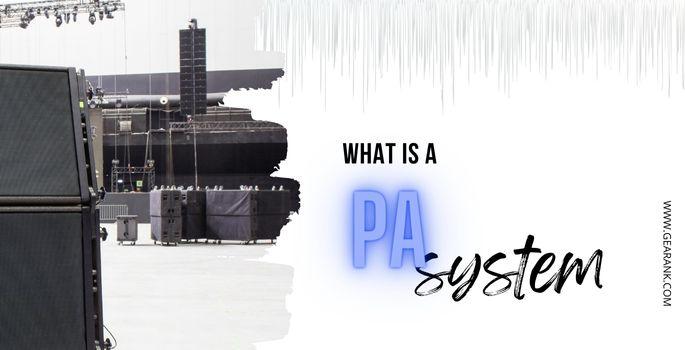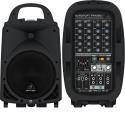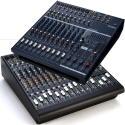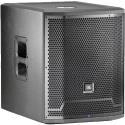What is a PA System? Public Address Systems Simply Explained

It's time to answer a question I get asked a lot. "What is a PA system?"
The PA system is at the core of most music and voice-related events. I know what you are thinking; this tells me nothing. That is why we are going to cover this question fully here. So make sure you read to the end so that the words "What is a pa system?" never pass your lips again.
Here we will go over a whole range of related topics. We will include the origins of the term PA, what makes up a PA, general operation, common uses, and more.
What does "PA" System Stand for?
Let's start by telling you what a PA system stands for. This part is easy. Our title gives it away. It's a Public Address System. The name says it all. A system used to amplify sound. Its purpose and function is to provide enough volume to address a crowd.
"It's the whole system used to amplify sound to a crowd."
What does a PA System Include?
IMPORTANT POINT
A PA system includes everything it takes to make this happen. That means all the devices used in this instance to project sound. A typical PA system will have mics, cables, a mixer, an amplifier, and a speaker. That can be just the start.
Where is a PA System Used?
A PA system is not limited to music. Its uses extend to:
- Theater
- Speeches
- Conferences
- Public Announcements
- Churches
- Educational facilities
And anything that involves projecting sound to an audience
What are the Different Types of PA Systems?
PA systems come in different shapes and forms. There are many hybrids and variations, so its difficult to put a definitive number on the types. Here are some good examples:
- Portable PA system
- Fixed PA system
- All-in-one mobile PA system
- Mini PA systems (like a powered speaker with basic mixer)
- Studio PA Systems
What do PA Systems do?
The primary role of a PA system is to allow people to hear music and voice more clearly.
In a conference room, PAs can amplify the presenter's speech so everyone can hear it. A school's principal can amplify their voice around the entire campus.
In a music setting, a band can use a portable PA system and PA speakers so their fans can hear them. Using a PA system is an important part of knowing how to start a band.
This is even more important in sports stadiums and other large venues.
One of the challenges with a large audience is to reach everyone with good-quality audio.
What is the Difference Between an Amplifier and PA System?
Let's get this common point of confusion out of the way. There is a difference between an amplifier and a PA system.
A conventional power amplifier is part of a PA system. It needs to be paired with a speaker and a mixer to serve as a PA system.
Some amplifiers, including FRFR-powered speakers, are designed to be mini PA systems. They usually come equipped with a mic input and basic multi-channel mixing controls.
What are the Components of a PA System?
Here are the components that make up a PA system. They cover every audio equipment that your sound passes through so they can reach the audience.
1. Microphones
You know what a microphone is, but here's a semi-technical explanation of how they work.
Mics are a piece of equipment that turn captured sound waves into electrical signals. These signals are then amplified and projected as audio signals by a speaker.
Mics are the most prominent component of PA systems. They are used by everyone who goes on stage, from MCs to singers, to important people like presidents. Mics capture the sound of instruments. These can be acoustic guitars; drums, pianos; violins, and all the other beautiful instruments. Oh, and they are also used to get the sound of a guitar amp to the mixer.
Different types of mics better handle alternate sonic characteristics of selected sound sources.
Getting the right type of mic in the correct position is critical to getting a PA system to sound great.
Apart from quality, the number of mics used is another critical factor. Using the PA system, there must be enough mics to handle an entire band, choir, or ensemble.
Oh, a tip I've just remembered: some PA system packages don't include microphones in their kit. More often than not, you'll have to buy mics separately. If you're a vocalist or regularly talk on stage, bringing your own is a good idea.
2. PA Amplifiers
Amplifiers work hand in hand with microphones and instruments to produce sound. Amplifiers increase audio signal strength and are the ones that drive speakers to work.
Older sound systems have a main amplifier that powers up multiple Passive speakers. Modern PAs use Powered PA speakers. All of which come with built-in amplifiers.
Instrument amps like Guitar amplifiers increase volume. But they are also tasked with tone shaping and coloration. Amplifiers substantially impact the sound quality of a PA system.
3. PA Mixers
A mixer combines the signals from sound sources like mics and instruments. It has multiple inputs to accommodate various audio sources. They include XLR, 1/4", RCA, stereo line inputs, and more.
As well as adjusting volume levels, most modern digital mixers have built-in effects. These can be independently applied to each channel.
Some speakers have built-in mixers but need the functionality of an external mixer. So even if you use one or two speakers for a small venue, you should get a dedicated mixer.
This is the device where most of the sound processing and volume balancing happens. In bigger productions, this can be a delicate balancing act. Only a trained individual (like an audio engineer) is equipped to handle this.
4. PA Speakers
With speaker systems, your audience will be able to hear you. Speakers are magical devices that convert electric signals into sound an audience can listen to. So it goes without saying that they are essential.
Basic PA System setups usually have two main speakers. The more complex your production, the more speakers and speaker stands you'll need.
Standard setups include two (Front of House) FOH speakers and multiple monitor speakers. Those who need extra bass will have a thumping PA subwoofer.
A single portable speaker can be enough for small crowds, like when a singer-songwriter is busking or spruiking in the street.
There are two main types of speakers, passive speaker and active speaker. Passive speakers need an external amplifier, while Active speakers have built-in amplifiers.
5. Monitors
Stage monitors are speakers directed toward the person performing or presenting. This way, they can hear themselves without depending on the FOH speakers, and waiting for the main sound to bounce off the wall.
Stage monitors are vital for musicians who need to hear themselves on stage. Even more so in loud settings.
Many PA speakers can double as monitors and vice versa.
6. Cabling
Cabling interconnects all the different pieces of equipment.
High-quality cabling will ensure better reliability and better sound quality too.
7. DI Boxes
DI Boxes solve impedance mismatches between instruments and a mixer or recording console.
These are essential devices to have for music-oriented setups. In this case, different types of instruments often plug straight into the mixer.
The Different Sizes Of PA Systems
PA systems are often categorized by the size of the crowd or venue they can support: small, medium, and large.
The larger the venue, the more complex the PA system needs to be. This type of setup may need the following:
- A mixer with plenty of channels;
- Multiple Line Array speakers;
- Tons of cables;
- Wireless systems;
- And more.
With medium to large sound systems, you will often have to buy components separately.
For small venues, you can go for the best portable PA systems. These are often all-in-one systems and are easy to set up and break down.
The type of system you need will vary depending on your situation. For example, a solo performer will only need a small system. In contrast, a band will need something more significant with more bells and whistles. Such a system will have more inputs, processing, projection capabilities.
Are Portable PA Systems Good?
Portable PA systems are ideal for musicians. They are quick to set up and easy to carry around, great for small venue gigs and mobile events.
Expect the features and connectivity to be limited. In spite of this, they should still have enough to meet the needs of a solo performer or a small ensemble. Sound projection will also be limited, so space should be a consideration.
One disadvantage of a portable pa system is having to set it up. Instead of just plugging in and playing, you must set up and test your PA system. You will need to do this each time you prepare for a performance.
But there is a plus side to this. Your sound will be consistent since you use the same system and settings. You will also have more control over the fine-tuning. You will no longer be at the mercy of a venue's poor audio system.
The best portable PA system kit usually comes with a speaker, a speaker stand, a basic mixer, and a power amp (built-in). There are even some that come with mics.
How to Set Up a Portable PA System?
Here are some setup tips for preventing common issues like feedback.
1. Keep your Mics Away from the Speakers
This should be simple enough most of the time. Sometimes this may be a challenge when setting up in compact spaces.
Make sure that there is a reasonable distance between the mic and the speakers. This way, you can avoid feedback and other unwanted audio interference.
2. Don't point Mics to Speakers
The direction of the mic is essential. Never point the mic to the speakers, and vice versa - don't point the speakers toward the mic holder.
This essential tip is sometimes lost among inexperienced singers, MCs, and presenters. To be safe, always remind mic users about this simple rule. This can save you from ear-piercing feedback and disruptions.
3. Check the position of your Speakers
PA speakers are often spaced to the left and right of a stage. This allows the speakers to distribute sound evenly. All this makes for a better listening experience.
The speaker distance and angle relative to your audience is very important. Speaker stands also play a big role. But this is a whole topic for another day.
To make the most of your speakers, mics, and other hardware, you must require ample sound check before performance.
Final Thoughts
You are now an unofficial expert on "What is a pa system?". You can now go and annoy people at parties with your newfound knowledge.
Jokes aside, you now know what it is, what it does, and its components. More importantly, you now have the information you need to start setting up a PA system.
But before going out and buying anything, you should read up on each of the components you need. Go ahead and use our site to help you with this. We have included links in this article that point to helpful articles that will assist you. Have fun on your PA system setup journey.
So there you have it. All your questions answered. Now, please repeat after me; I will never ask again, "What is a PA system?"












